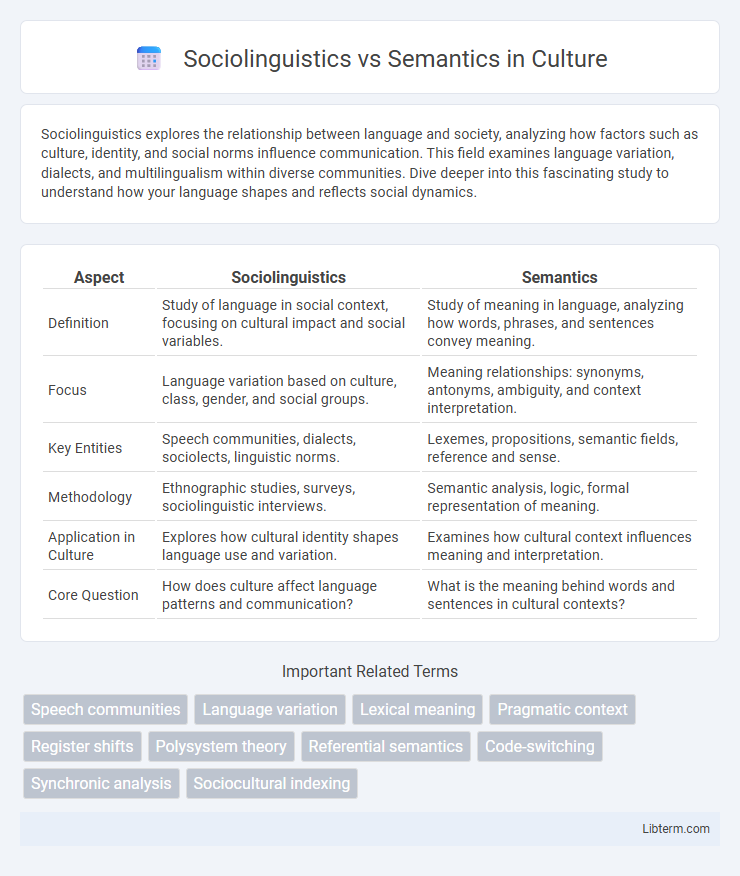Sociolinguistics explores the relationship between language and society, analyzing how factors such as culture, identity, and social norms influence communication. This field examines language variation, dialects, and multilingualism within diverse communities. Dive deeper into this fascinating study to understand how your language shapes and reflects social dynamics.
Table of Comparison
| Aspect | Sociolinguistics | Semantics |
|---|---|---|
| Definition | Study of language in social context, focusing on cultural impact and social variables. | Study of meaning in language, analyzing how words, phrases, and sentences convey meaning. |
| Focus | Language variation based on culture, class, gender, and social groups. | Meaning relationships: synonyms, antonyms, ambiguity, and context interpretation. |
| Key Entities | Speech communities, dialects, sociolects, linguistic norms. | Lexemes, propositions, semantic fields, reference and sense. |
| Methodology | Ethnographic studies, surveys, sociolinguistic interviews. | Semantic analysis, logic, formal representation of meaning. |
| Application in Culture | Explores how cultural identity shapes language use and variation. | Examines how cultural context influences meaning and interpretation. |
| Core Question | How does culture affect language patterns and communication? | What is the meaning behind words and sentences in cultural contexts? |
Introduction to Sociolinguistics and Semantics
Sociolinguistics studies how language varies and functions within social contexts, exploring factors such as ethnicity, gender, and socioeconomic status that influence language use and communication patterns. Semantics, on the other hand, focuses on the meaning of words, phrases, and sentences, analyzing how language conveys and interprets meaning across different contexts. Both fields intersect in understanding how meaning is shaped not only by linguistic structures but also by social interactions and cultural norms.
Defining Sociolinguistics: Scope and Focus
Sociolinguistics examines the relationship between language and society, analyzing how social factors such as class, ethnicity, gender, and age influence language variation and use. It explores phenomena like code-switching, dialectal differences, and language attitudes within specific communities. The scope of sociolinguistics includes both macro-level social contexts and micro-level conversational interactions, distinguishing it from semantics, which concentrates primarily on meaning and interpretation within language.
Understanding Semantics: Key Concepts
Semantics studies meaning in language by analyzing word meanings, sentence structures, and context to understand how meaning is constructed and interpreted. It focuses on key concepts such as sense, reference, connotation, and ambiguity to explain how meaning varies and evolves. Understanding semantics enhances communication clarity and supports fields like linguistics, artificial intelligence, and language learning.
Historical Development of Both Fields
Sociolinguistics emerged in the mid-20th century with pioneering studies by William Labov focusing on language variation and social factors, highlighting how language reflects societal structures. Semantics has deeper historical roots dating back to ancient philosophy, evolving through the works of Gottlob Frege and Charles Ogden in the early 20th century, emphasizing the study of meaning in language. Both fields developed through distinct intellectual traditions, with sociolinguistics integrating empirical social research and semantics advancing formal theories of meaning and reference.
Methodologies in Sociolinguistics vs Semantics
Sociolinguistics employs ethnographic observation, interviews, and participant observation to study language variation and social context, emphasizing qualitative data and social interaction patterns. Semantics focuses on formal analyses using logic, set theory, and computational modeling to explore meaning, truth conditions, and lexical relations within language. The methodological divergence highlights sociolinguistics' qualitative, context-driven approach versus semantics' formal, systematic examination of meaning.
Key Differences Between Sociolinguistics and Semantics
Sociolinguistics studies the relationship between language and society, examining how social factors like culture, ethnicity, and context influence language use and variation. Semantics focuses on the meaning of words, phrases, and sentences, analyzing how language encodes and conveys meaning. Key differences lie in sociolinguistics emphasizing social context and variation, while semantics centers on the intrinsic meaning within language structures.
Overlapping Areas and Interdisciplinary Connections
Sociolinguistics and semantics intersect in exploring how meaning varies across social contexts, with sociolinguistics examining language use shaped by social factors and semantics focusing on the meaning conveyed by linguistic expressions. Both fields analyze pragmatic elements such as speech acts, implicature, and context-dependent interpretations to understand how social identities and cultural norms influence meaning. Interdisciplinary connections emerge in studying phenomena like politeness strategies, language variation, and semantic shifts driven by social interaction and community practices.
Practical Applications in Language Analysis
Sociolinguistics analyzes how language varies across social groups and contexts, providing insights into language use in real-world communication and informing language policy, education, and speech therapy. Semantics studies meaning in language, enabling precise interpretation and development of natural language processing applications like machine translation and sentiment analysis. Combining sociolinguistics and semantics enhances language analysis by addressing both social variation and meaning, improving dialogue systems and cross-cultural communication tools.
Challenges in Sociolinguistics and Semantics Research
Challenges in sociolinguistics research include accounting for the dynamic nature of language variation across social contexts and accurately interpreting the influence of social factors such as ethnicity, gender, and socioeconomic status on language use. Semantics research faces difficulties in precisely defining meaning in diverse linguistic structures, handling ambiguity, and modeling context-dependent interpretations within natural language processing systems. Both fields require interdisciplinary approaches to address complexities in human communication and language understanding effectively.
Future Directions and Emerging Trends
Sociolinguistics is increasingly integrating computational methods and big data analysis to explore language variation and social identity in digital communication, while semantics advances through interdisciplinary approaches combining cognitive science and artificial intelligence to model meaning more dynamically. Emerging trends reveal a convergence where sociolinguistic context informs semantic interpretation in natural language processing, enhancing machine understanding of pragmatics and discourse variability. Future directions emphasize ethical considerations and inclusivity, promoting research into how multilingualism and cultural diversity shape evolving linguistic meaning and identity online.
Sociolinguistics Infographic

 libterm.com
libterm.com